900 Asylum Seekers Returned to Wait in Mexican Border City
The United States government has sent about 900 mostly Central American and Cuban migrants back to this northern Mexico border city since expanding it’s controversial “remain in Mexico” program to the easternmost point on the shared border two weeks ago, Mexican authorities say.
They are among nearly 3,000 people with pending U.S. immigration proceedings who have been sent back to wait in Mexico’s Tamaulipas state, where the U.S. State Department warns Americans to avoid all travel due to high levels of violence and kidnapping.
Under the program, migrants who turn themselves over to U.S. authorities and, in most cases, request asylum, are returned to Mexico after being given a court date. To pursue the asylum cases they have to wait in Mexico, crossing only for court dates in what is a months-long process.
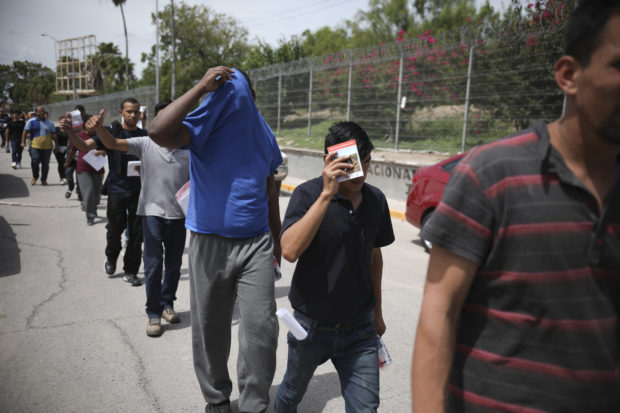
Migrants return to Mexico, using the Puerta Mexico bridge that crosses the Rio Grande river, in Matamoros, Mexico, Wednesday, July 31, 2019, on the border with Brownsville, Texas. The United States government has sent some 800 mostly Central American and Cuban immigrants back to this northern Mexico border city since expanding its controversial plan to this easternmost point on the shared border two weeks ago, according to local Mexican authorities. (AP Photo/Emilio Espejel)
The program began in January at Tijuana, across from San Diego, and the U.S. government has been expanding it eastward along the border, seeing it as an effective deterrent to the flood of migrants. U.S. authorities began returning migrants at the Tamaulipas city of Nuevo Laredo, on the border with Laredo, Texas, in early July and a few days later added Matamoros, across from Brownsville.
So far more than 20,000 migrants have been returned all along the border to wait in Mexico, Mexican officials say.
On Thursday, some 70 migrants walked sullenly with their heads down across the international bridge into Matamoros. They carried their documents in transparent plastic bags and expressed concerns about how they would wait out the process in a state known for powerful organized crime gangs.
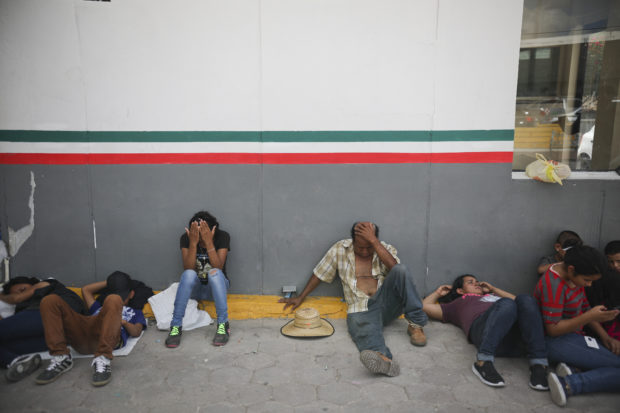
Migrants rest near a Mexican immigration center where people have set up a camp to sleep in Matamoros, Mexico, Thursday, Aug. 1, 2019, on the border with Brownsville, Texas. The United States government has sent some 800 mostly Central American and Cuban immigrants back to this northern Mexico border city since expanding its controversial plan to this easternmost point on the shared border two weeks ago, according to local Mexican authorities. (AP Photo/Emilio Espejel)
“Donald Trump is just returning everyone,” said Emilio Cáceres, a 25-year-old Honduran farmer who said he planned to go home rather than wait. Cáceres said he previously was deported from the U.S. and therefore did not envisage a successful asylum application even though he was given a hearing date.
Over 100 more returned Friday.
Earlier in the week, Luis Raxic of Guatemala was returned to Matamoros with his wife and 1½-year-old daughter. He had similar thoughts of giving up and going home because he did not want to expose his daughter to the danger of waiting here.
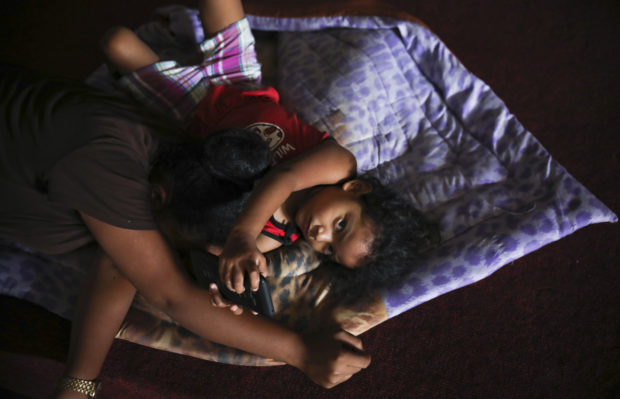
A young migrant from Cuba looks up at the camera inside Viento Recio church, serving as a migrant shelter in Matamoros, Mexico, Thursday, Aug. 1, 2019, on the border with Brownsville, Texas. The United States government has sent some 800 mostly Central American and Cuban immigrants back to this northern Mexico border city since expanding its controversial plan to this easternmost point on the shared border two weeks ago, according to local Mexican authorities. (AP Photo/Emilio Espejel)
“One of the agents told us very clearly that they were going to deport us, but only to Mexico and not to our country to save money,” Raxic said. “It’s a strategy to make us scared and so we’ll go back.”
The U.S. is sending back groups of 50 to 100 migrants almost daily to Matamoros, the Tamaulipas state immigration office says.
Mexico began busing some of the returned migrants out of Tamaulipas to the city of Monterrey in neighboring Nuevo Leon state last month. Authorities said it was for their safety, but many were dropped off in that unfamiliar city in the middle of the night. It was unclear how they would return to the border for their court dates.
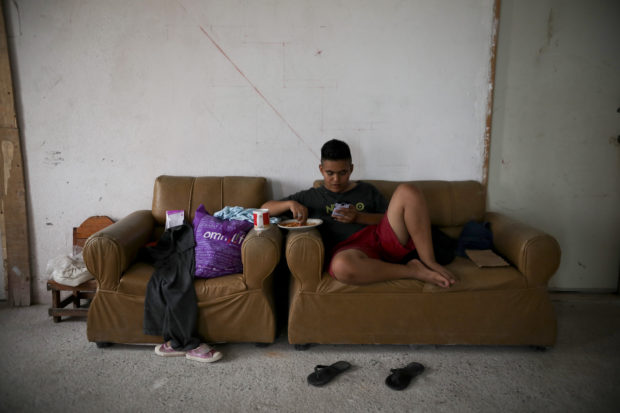
A migrant from Honduras eats a snack while looking at a smartphone inside Viento Recio church, which is serving as a migrant shelter, in Matamoros, Mexico, Thursday, Aug. 1, 2019, on the border with Brownsville, Texas. Some migrants are waiting for their names to be called from a list of more than 1,000 names long to apply for asylum in the U.S. while others have recently been returned and are awaiting court dates. (AP Photo/Emilio Espejel)
Raxic waited for the bus to Monterrey, saying from there his family would look for a way back to Guatemala.
Sensing the danger or already knowing Tamaulipas’ reputation, some migrants quickly disperse upon reaching Matamoros in search of lodging and are not seen in the streets. Others choose to stay near the downtown bridge where police and National Guard are present. Some have yet to cross over to the U.S. to file asylum applications and are waiting to be called from a list of more than 1,000 names. Others have recently been returned and are awaiting court dates.
A dozen tents are pitched in the bridge’s shadow. Some people simply curl up on blankets in the sweltering heat. In addition to Central Americans, there are migrants from Cameroon, Cuba, and Peru.
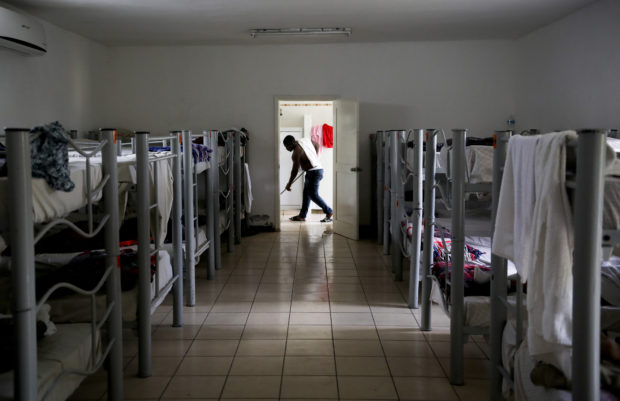
A migrant from Cameroon cleans the floor of “La Casa del Migrante” shelter for migrants in Matamoros, Mexico, Thursday, Aug. 1, 2019, on the border with Brownsville, Texas. The United States government has sent some 800 mostly Central American and Cuban immigrants back to this northern Mexico border city since expanding its controversial plan to this easternmost point on the shared border two weeks ago, according to local Mexican authorities. (AP Photo/Emilio Espejel)
Mexico has said it will provide more shelter space and job opportunities for migrants sent back to Mexico. On Thursday, the government opened a new shelter in Ciudad Juarez across from El Paso, Texas, where the U.S. is also returning asylum seekers.
Two Matamoros shelters visited by The Associated Press on Thursday were at less than half their capacity, even though some of the migrants camped near the bridge had heard otherwise.
Daisy Maldonado of Honduras sat on the ground playing with her 2-year-old daughter. She and her husband were afraid to move far from the bridge to look for housing or work.
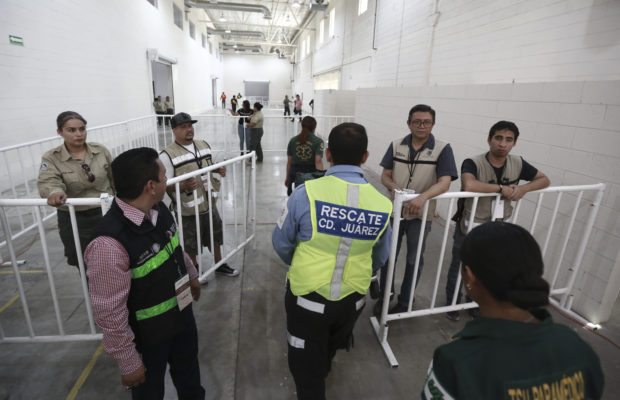
Mexican government workers walk inside the newly opened migrant shelter, formerly an assembly plant, in Ciudad Juarez, Mexico, Thursday, Aug. 1, 2019. The Mexican government opened its first shelter here to house Central American and other migrants seeking asylum in the United States who have been sent back to Mexico to await the process. (AP Photo/Christian Chavez)
“Since they’ve told us there is no space in the shelters, why risk it?” she said.
It wasn’t clear who had told her that, but many migrants repeated the same information.
Walter Enamorado, from El Salvador, has been sleeping outside the state immigration office near the bridge with his 7-year-old son.
“We’re abandoned here, but they haven’t even told us if there’s a shelter or how to get there,” he said.
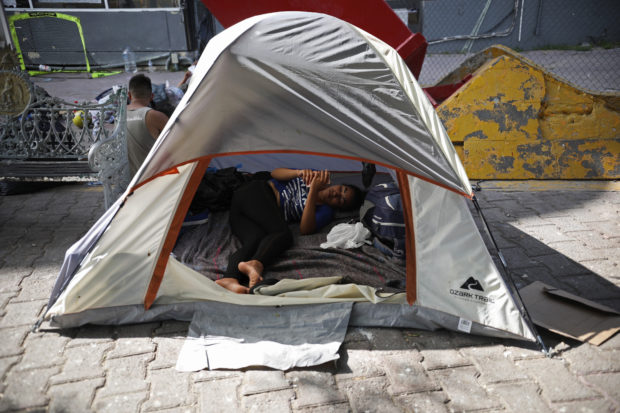
A migrant rests inside a tent pitched near a Mexican immigration center where people have set up camp to sleep in Matamoros, Mexico, Thursday, Aug. 1, 2019, on the border with Brownsville, Texas. The United States government has sent some 800 mostly Central American and Cuban immigrants back to this northern Mexico border city since expanding its controversial plan to this easternmost point on the shared border two weeks ago, according to local Mexican authorities. (AP Photo/Emilio Espejel)

